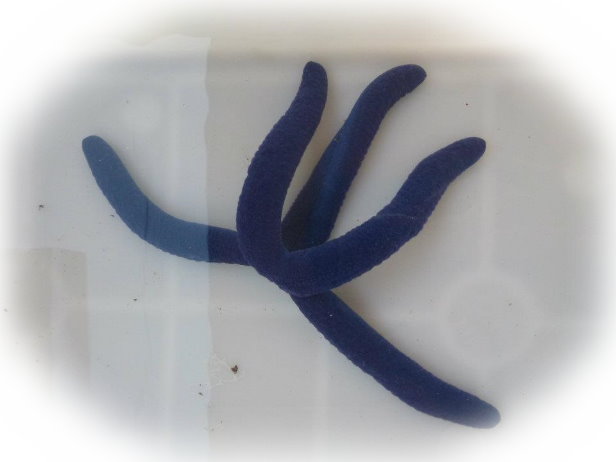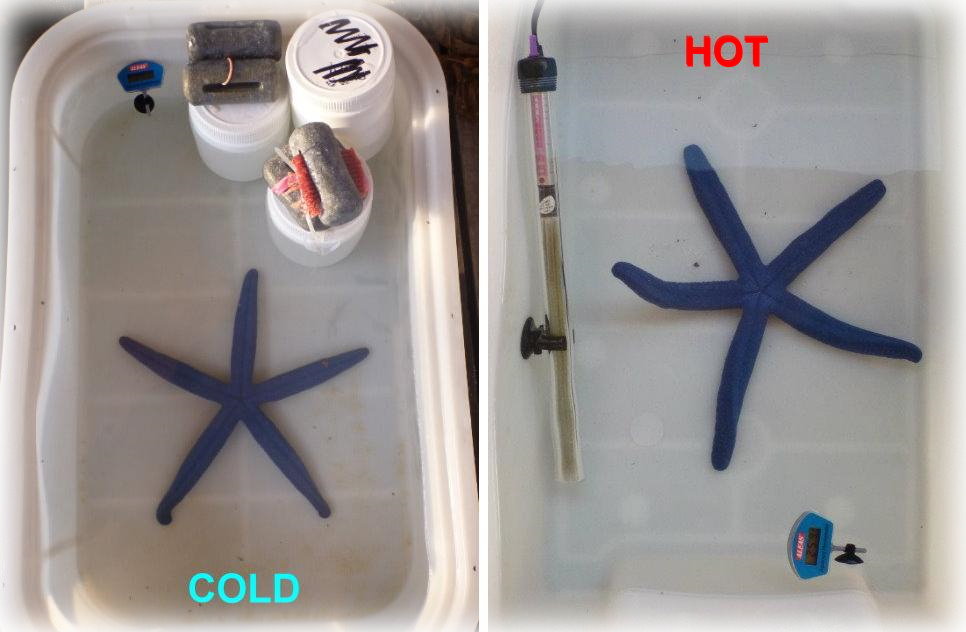Behaviour
Feeding Behaviour
Linckia laevigata mainly feeds on coralline algae and detritus (Coleman 2007; Laxton 1974). Like what most of the other asteroids do, L. laevigata feeds extraorally (i.e. outside of the body) by everting its cardiac stomach through the mouth (Laxton 1974; Ruppert, Fox & Barnes 2004; Thompson & Thompson 1982). The everted stomach is approximately 4cm long and usually no feeding marks are left (Thompson & Thompson 1982).
Reproductive Behaviour
Linckia laevigata is gonochoristic. In other words, they have separate male and female individuals (Yamaguchi 1977). When sexually mature, L. laevigata release eggs and sperms into the water column, where fertilization takes place (Yamaguchi 1977). Males were observed to spawn before females in the lab and both sperms and eggs are milky white in color in this species (Laxton 1974).
Locomotion
According to the results of a previous study on the movements of L. laevigata, this sea star species tends to move unidirectionally (Thompson & Thompson 1982). This behavior results in a beneficial effect as the animal will be prevented from feeding on a previously grazed area (Thompson & Thompson 1982). L. laevigata individuals were also observed to show relatively faster and random directional movements when they were being translocated on sand (Thompson & Thompson 1982). In addition, movement is generally greater at night than during the day (Laxton 1974; Thompson & Thompson 1982)
Normal Position
The normal position of a sea star is maintained by keeping its ventral surface (and the tube feet) in contact with a substratum (Boolootian 1966). Since normal position is kept as long as the tube feet of a sea star are in contact with a surface, L. laevigata can crawl up the side of an aquarium and maintain its ‘normal position’ regardless of gravity.
Righting
Like the other sea star species, Linckia laevigata is able to
right itself when it is being turned over and remained in an upside down
position (i.e. the oral side of the animal is facing upward). Previous
literature suggested that the righting reflex of a sea star is caused by
the positive stereotropism of the tube feet, that is, the tendency of
the tube feet to adhere and in response to the contact of a surface
(Moore 1910).
Somersault, which is the most generally used righting method by the asteroids (Clark 1968), was also commonly observed in the righting experiment of the L. laevigata
|
|
 |
The Righting Experiment of Linckia laevigata
SUMMARY
In order to investigate the effect of temperature on the righting reflex of the tropical sea star species, Linckia laevigata, an experiment was carried out on the Heron Island research station with five L. laevigata specimens collected from the Heron Island Reef, Southern Great Barrier Reef. In this experiment, it was predicted that temperature change will influence the righting time of the blue sea stars ( L. laevigata). Results of the experiment indicated that there is a significant difference (p<0.05) in the righting time of L. laevigata placed in the three temperature conditions (cold treatment, control and hot treatment).
METHODS
A total of five blue sea stars ( L. Laevigata) were collected in September 2011 from the Shark Bay of Heron Island Reef, Southern Great Barrier Reef. Individuals were transferred back to the research station and were kept together in an aquarium with running sea water directly pumped from the sea. During the experiment, each individual was placed in a separate tank equipped with an aquarium thermometer.
In the control experiment, water temperatures varied naturally from 22.0°C to 23.0°C. Animals were placed in an upside down position and the righting time was measured with a stop watch. The righting process was considered complete once the individual was returned back to its original position (i.e. aboral side facing upward and no arms were neither twisted together nor overlapping) and timing was stopped.
After collecting the data for the control conditions, water temperatures were either increased or decrease gradually to the targeted temperature within an hour (cold treatment = 20°C and hot treatment = 26°C). One of the five blue sea stars was excluded from the hot/cold treatment as two of its arms were wounded. As a result, two blue sea stars were subjected to the hot treatment and the other two were subjected to the cold treatment. In the cold treatment tanks, temperatures were controlled with small containers filled with ice (3 containers per tank). Ice was replaced regularly and weights were placed on top of each container, ensuring that the containers were hold in place and not floating around. On the other hand, temperatures in the hot treatment tanks were controlled with an aquarium heater.

The righting time was measured after the blue sea stars were subjected to the treatment conditions for at least 4 hours. After the measurement, ice and heater were removed from the tanks and temperatures were allowed to return to normal naturally throughout the night.
The whole experiment (data collection of both control condition and treatments) was then repeated in the next morning (i.e. Day 2). Nevertheless, in order to obtain more biological replicates, the two blue sea stars that were previously subjected to the hot treatment in Day 1 were then placed in the cold treatment tanks on the second day, and vice versa for the other two specimens.
Data collected was then subjected to statistical analysis and significant differences were determined by one-way ANOVA (p<0.05).
RESULTS
Under control conditions, the mean righting time of the blue sea stars was 27.3 minutes. The mean righting times for the individuals in the cold and hot treatments were 22.5 minutes and 62.2 minutes respectively. Statistical analysis of the experimental data indicated that there was a significant difference in the blue sea star righting time between the three temperature conditions (p<0.05).
Fig. 1) Average righting time (minute) of blue sea stars (L. laevigata) under hot treatment, control condition and cold treatment (with 95% confidence limits)
|